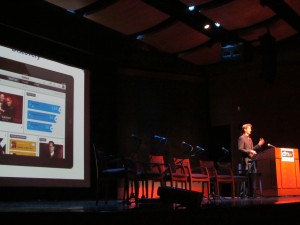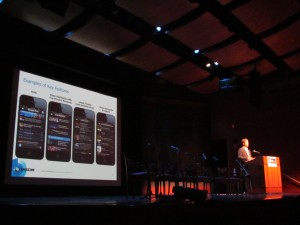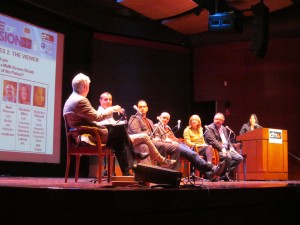On November 16th, a one day conference held at the Museum of Jewish Heritage brought out the best and brightest in Television to talk about the future, and that meant digital media. TiVo, YouTube, Netflix, and Social Media were all on the table, or more specifically, giant screens complete with a social media feed of those tweeting about the event in real-time. This neophyte reporter suspected that what they had to say had some bearing on the future of comics, and particularly on how comics are marketed and discussed, and I heard a few sound bytes of wisdom. The bottom line I came away with was: video. The role of shareable video in spreading media awareness of new projects was a consistent theme addressed in several panels.
Maybe I’m just easily shocked, but when I heard that TV executives are well aware that they need to develop content to “live on all platforms” including second, third, and fourth screens such as iPads and smart-phones, and are pondering deeply how to “tap into communities organically” online, I knew that digital had arrived and even superceded traditional cable TV. It’s all about online promotion these days, and that means trying to encourage viral spread. XBox are very excited about their growing interactive programs, particularly for kids, where viewers can feel part of the show. Living room viewing is becoming more like internet viewing every day. They key to developing this more web-like experience for viewers seems to be “getting to know them” in the same way that sites like Facebook pick up on your preferences and try to market to you.
This signals a radical shift, actually, because formerly TV strategists would target only the largest demographics for their ads. Not anymore. Now it’s all about casting the net as widely as possible and catering to diversity. They may still go for selling their advertisers’ top brands, but it’s all about niche markets and overall sales. Advertisers, in turn, want to use Tumblr, Facebook. Twitter, and even Instagram to establish brand presences, and they want digital TV to be their go-to system for doing so. This “micro-targeting” captures viewers well after the original airtimes for shows by including plenty of “extras” in online content, like webisodes, discussion groups, previews, and interactive features on their websites. Anyone who watches some form of TV must have been aware of these developments over time, particularly heralded by ads when the actors from your favorite show announce that you can see more footage on the show or network’s website, but as far as the future of TV goes, expect extreme growth in this kind of extra content.
Animation is one of the biggest mediums leading the way in this shift. Executives from SMOSH and Xbox are expanding games and extra animation on websites by including side-stories starring minor characters from popular shows. They recognize, in fact, that the game-players and extra content watchers might not even be the same audience who are watching the show on TV, but are building up secondary audiences who spread the word through social media. The market forecast for networks developing original online content is set to spring from an estimated 135 million dollars to double that figure in 2013. Networks currently produce 60% of their material as online content, but that will rise to at least 80% in the coming year. Those are staggering figures that show the dominance that digital media is exercising when it comes to entertainment.
YouTube was the focus of attention when it came to budgeting and promotion, since YouTube costs remain so low. They also produce highly sharable video, creating a particularly close relationship to Facebook. My second wake-up call of the day was learning that 65% of all video content shared online is shared through Facebook. We all know Facebook can eat your day, and we’ve probably resisted watching those cute kitten videos, but the marketing impact of Facebook is skyrocketing. Maybe it’s time to think more seriously about what free video content can do for comics. It may not be a natural association to think of promoting a webcomics platform you’re starting by making a goofy video with the comics creators themselves, but take the time to give that a second thought. After all, Kickstarter insists on a video promo, so why not consider the possibilities? During a break, another conference-goer, hearing that I was into comics, confided that a friend of his recently created a video promo for his comic. The comics creator had some trepidation showing it to a publisher, but he bit the bullet and decided to be experimental. Not only was he praised for his innovation, but he left with a contract for his work.
Digital thinkers working for TV companies are scrambling to monetize the video sharing phenomenon in some way. The shared video content watched online associated with video games alone far outstrips the number of hours the public spends watching actual TV. Viewers these days are described as “digital omnivores” who move through various digital devices throughout the day “snacking” while waiting in line at Starbucks or at a movie theatre. If TV can become part of the “snacking” phenomenon then there’s a future for TV. If not, well, this “transition” period as the industry calls it, may produce a bleaker period than they’d like.
The most impressive panel of the day in my mind was the final discussion on “Being Discovered” in a digital media world. Matt Graham, Director of Content Development for PBS Interactive, Brian Curtis, Senior Director of Product Management for Video Content with Comcast, Tom Boland, Senior Vice President for Social Ogilvy, Matthew Hanover, Head of Business Development for TVPlus, and Mark Ghuneim, CEO of Wiredset hit the challenges of spreading new content head on. Their hot topic: apps geared toward TV watchers. Apps like Zeebox, Getglue, and Shazam had been fighting it out all day for top features, but Comcast still held its ground on using set top boxes to produce interactive TV for viewers. For those who haven’t seen or used these apps, entering a few pieces of information on your phone or tablet enables you to get a full listing of programs currently running, can select information about programs, link directly to show websites, and of course, plug right into the social media discussion going on online in real-time. These apps are all geared toward “content discovery”, helping viewers find the shows they don’t even know they want to watch. Matt Graham of PBS calls the current climate a “punk rock revolutionary disruptive moment”.
“Disruptive” was another key adjective used at the conference to highlight the more dangerous shake-ups facing TV right now, but Graham had a positive tone. If networks can make savvy decisions and take advantage of the chaos by choosing good strategies for outreach, they’ll be more equipped to weather the digital storm. PBS still holds true to its mission, Graham announced, to “deliver educationally enlightening content to every American” and to make it available “wherever people are consuming content”. He’s prepared to go where the consumer goes. PBS is enthusiastic about social media because a lot of social media promotion is low-cost, but the consensus among panelists is that, for now, companies are all placing a “variety of bets” because in a word that’s changing digitally every day, no one feels sure where things are going. Clearly the locus of this “disruptive” phenomenon is digital media. What might this all mean for comics? Take advantage of low cost social media advertizing to be “discovered”. Develop apps where possible and applicable. Who knows? Soon people may be reading your comic on their flat screens in their living rooms, that is, if they aren’t already.
Hannah Means-Shannon writes and blogs about comics for TRIP CITY and Sequart.org and is currently working on books about Neil Gaiman and Alan Moore for Sequart. She is @hannahmenzies on Twitter and hannahmenziesblog on WordPress.















Awesome post Hanna. In a big way, this is one of those outlier moments that adds momentum to the growth of the comics world.
So instead of a backdoor pilot in a series (think “Mork and Mindy” appearing first on “Happy Days”), you have a secondary series online featuring a character who appears on a webisode, and who might develop into a mainstream property (kinda like how Fonzie was originally a secondary character on “Happy Days”).
I recently watched the two-part Ken Burns “Dust Bowl” documentary on PBS, and went online to view the website. It’s clean and easy to navigate, with lots of great content, and links to buy the DVD and companion book.
Thanks guys! Yes, Torsten, your comparisons are apt. With video games too, they are adding short cartoons or games featuring minor characters and those are developing cult followings of their own for whatever reasons.
It was amazing how shaken up the TV execs are by this digital shift- only Comcast acted kind of stolid about it, but they are scrambling with new ways to keep up. They really feel that interactive TV- interactive even on the main screen- is where things are going. That TV will become netcentric. Wild.
Comments are closed.